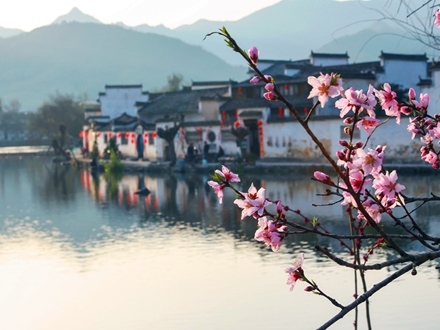ranchosantafenow.net – Nestled in the picturesque landscapes of southern Anhui Province, Hong Village (Hongcun) is a quintessential example of a traditional Chinese village that has retained its historical charm and cultural significance. Renowned for its stunning architecture and serene environment, Hong Village offers a unique glimpse into China’s rich heritage and rural life.
Historical Background
Hong Village dates back to the Song Dynasty (960–1279 AD) and has been remarkably preserved over the centuries. Originally established by the Wang clan, the village’s layout was meticulously designed to resemble the shape of an ox, with the Leigang Hill as its head and two trees standing as its horns. A network of canals flowing through the village represents the ox’s intestines, symbolizing prosperity and wealth.
Architectural Marvels
The architecture of Hong Village is a testament to the ingenuity and craftsmanship of ancient Chinese builders. The village is home to over 140 well-preserved houses from the Ming and Qing Dynasties, showcasing traditional Hui-style architecture. Characterized by whitewashed walls, grey-tiled roofs, and intricate wood carvings, these structures exude elegance and sophistication.
One of the most iconic landmarks in Hong Village is the Moon Pond (Yue Zhao), a crescent-shaped water body that reflects the surrounding buildings and creates a serene and picturesque ambiance. The Chengzhi Hall, known as the “Folk Palace Museum,” is another architectural highlight, featuring exquisite woodwork and stone carvings.
Cultural Significance
Hong Village is not only a visual delight but also a cultural treasure trove. It was inscribed as a UNESCO World Heritage Site in 2000, along with the nearby Xidi Village, for its outstanding representation of a traditional Chinese settlement. The village’s design and architecture have inspired many artists and filmmakers, including the acclaimed director Ang Lee, who used Hong Village as a filming location for the movie “Crouching Tiger, Hidden Dragon.”
A Journey Through Rural Life
Visitors to Hong Village can immerse themselves in the tranquil beauty of rural China while exploring its narrow cobblestone streets and ancient structures. The village offers a variety of cultural experiences, from traditional tea ceremonies to calligraphy workshops. Local artisans showcase their skills in crafting handmade products, providing a glimpse into the village’s vibrant cultural heritage.
Conclusion
Hong Village stands as a testament to China’s rich history and cultural diversity. Its well-preserved architecture, picturesque landscapes, and vibrant cultural life make it a must-visit destination for anyone interested in exploring the timeless beauty of China’s countryside. Whether you’re an architecture enthusiast, a history buff, or simply a traveler seeking tranquility, Hong Village offers an unforgettable experience that transports you back in time.
